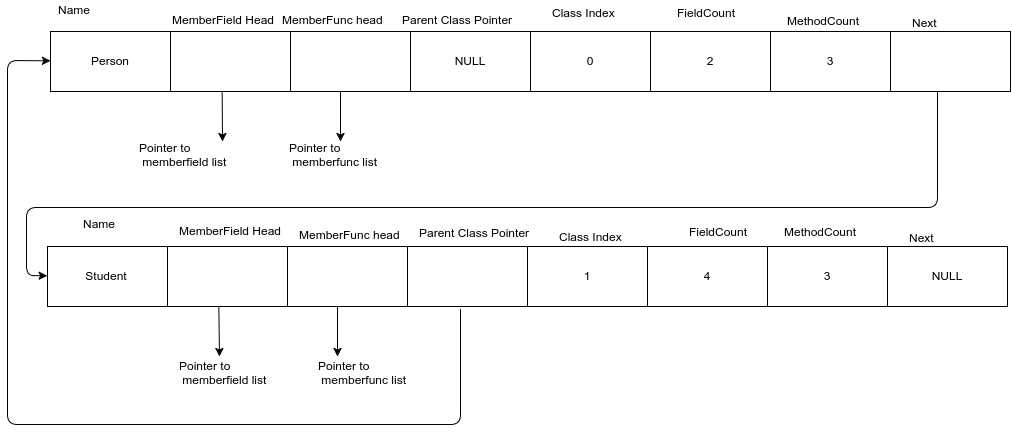Class Table¶
Introduction¶
The class table stores information pertaining to all the classes declared in an ExpL program. For a class it stores member fields, member functions, name of the class and parent class pointer.
Structure¶
The structure of Class Table(CT) is as follows:
struct Classtable {
char *Name; //name of the class
struct Fieldlist *Memberfield; //pointer to Fieldlist
struct Memberfunclist *Vfuncptr; //pointer to Memberfunclist
struct Classtable *Parentptr; //pointer to the parent's class table
int Class_index; //position of the class in the virtual function table
int Fieldcount; //count of fields
int Methodcount; //count of methods
struct Classtable *Next; //pointer to next class table entry
};
struct Fieldlist{
char *Name; //name of the field
int Fieldindex; //position of the field
struct Typetable *Type; //pointer to typetable
struct Classtable *Ctype; //pointer to the class containing the field
struct Fieldlist *Next; //pointer to next fieldlist entry
};
Memberfunc list is used to store the information regarding the type, name of the function, argument list, it's flabel and it's position.
struct Memberfunclist {
char *Name; //name of the member function in the class
struct Typetable *Type; //pointer to typetable
struct Paramstruct *paramlist; //pointer to the head of the formal parameter list
int Funcposition; //position of the function in the class table
int Flabel; //A label for identifying the starting address of the function's code in the memory
struct Memberfunclist *Next; //pointer to next Memberfunclist entry
};
Associated Methods¶
-
struct Classtable* CInstall(char *name,char *parent_class_name)Creates a class table entry of given 'name' and extends the fields and the methods of parent class.
-
struct Classtable* CLookup(char *name)Search for a class table entry with the given 'name', if exists, return pointer to class table entry else return NULL.
-
void Class_Finstall(struct Classtable *cptr, char *typename, char *name)Installs the field into the given class table entry which is given as an argument.
-
void Class_Minstall(struct Classtable *cptr, char *name, struct Typetable *type, struct Paramstruct *arglist)Installs the method into the given class table entry which is given as an argument.
Illustration¶
Here is an example illustrating it.
class
Person{
decl
str name;
int age;
int printDetails();
str findName();
int createPerson(str name, int age);
enddecl
int printDetails(){
decl
enddecl
begin
write(self.name);
write(self.age);
return 1;
end
}
str findName(){
decl
enddecl
begin
return self.name;
end
}
int createPerson(str name, int age){
decl
enddecl
begin
self.name=name;
self.age=age;
return 1;
end
}
} /*end of Person class */
Student extends Person{
decl
int rollnumber; /* The members name and age are inherited from the parent class */
str dept;
int printDetails();
int createStudent(str name, int age,int rollNo, str dept);
enddecl
int createStudent(str name, int age,int rollNo, str dept){
decl
enddecl
begin
self.name =name;
self.age = age;
self.rollnumber = rollNo;
self.dept = dept;
return 1;
end
}
int printDetails(){ /* This function is also overridden in the derived class */
decl
enddecl
begin
write(self.name);
write(self.age);
write(self.rollnumber);
write(self.dept);
return 1;
end
} /** The derived class inherits the findName() function from the parent **/
} /* end of student class */
endclass
-
As soon as the compiler encounters the class name , it installs the class name and the parent class name if present into the class table. Subsequently, If there is an extension to the parent class, all the member fields and methods of parent class are inherited. Following is how class table looks when person is installed.

-
Following is how class table looks when student class is installed.
